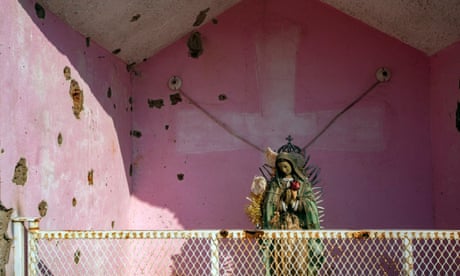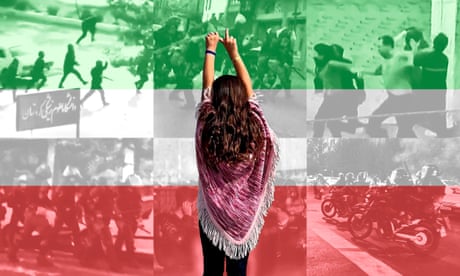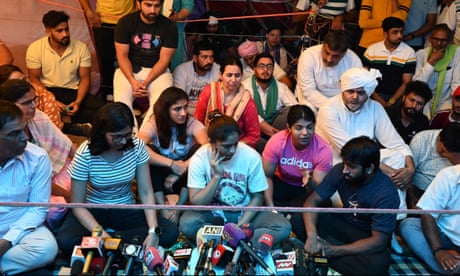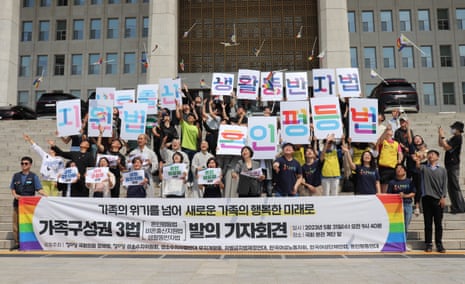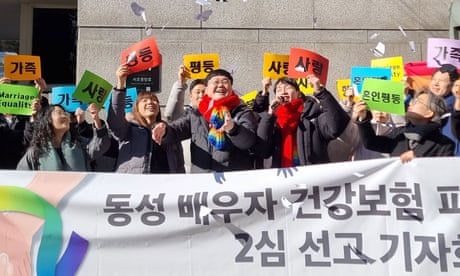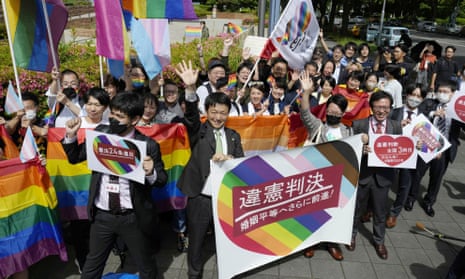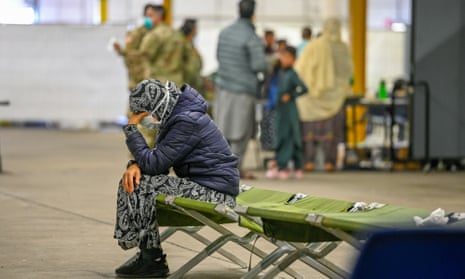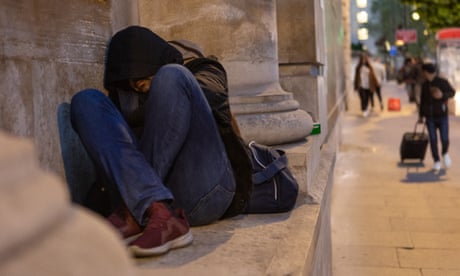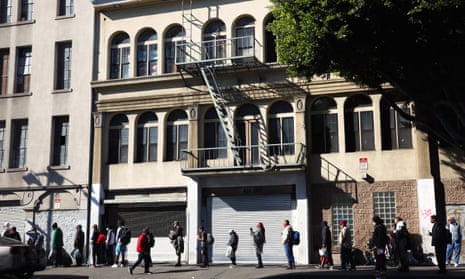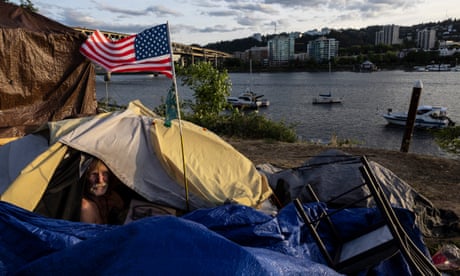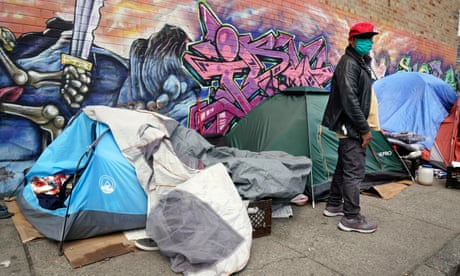Indigenous boutique owners Liana Shewey and Korina Emmerich want to acknowledge traditions but also push the design narrative
The New Face of Small Business
Indigenous peoples
Sophia Herring
Location, location, location. It can make or break a business. For Liana Shewey and Korina Emmerich, it was a call to action. When a mutual friend told the activists and creatives – Shewey is an educator and Emmerich is a fashion designer – about a newly vacant storefront on the ground floor of her mother’s Manhattan co-op building, the pair, who met five years ago at an Indigenous women’s collective and quickly became best friends, visited the space. It was 350 sq ft – a far cry from the 20,000 sq ft clubhouse of the duo’s wildest fantasies. But something felt right. “We jumped on it,” said Shewey.
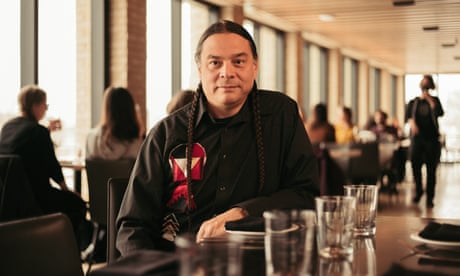
The Sioux Chef’s Owamni restaurant wows critics – and decolonizes cuisine
The co-op board wasn’t willing to hand the keys over to just anyone. But their friend’s mother is Navajo, and also the board president. Within days the building had its newest tenant: Relative Arts NYC, a boutique that carries pieces by Indigenous designers and also hosts literary readings, album releases and art installations featuring work by Indigenous artists.
“It just felt so important for us to have a space, as grassroots organizers in the city,” said Shewey, who was raised in Stillwater, Oklahoma, and is a member of the Mvskoke (Creek) Nation. Building a store that specializes in goods from Indigenous and many female-owned labels was a natural way to support their community. According to research from 2021, Indigenous women working full time were typically paid $0.57 for every $1 paid to white, non-Hispanic men. The two had long lamented the scarcity of Indigenous-owned businesses in New York (about .5% of business owners in the US are Indigenous, despite making up approximately 3% of the population).

The merchandise builds on their mission to shatter stereotypes. The entrepreneurs speak to “Indigenous futurism”, an emerging art and design movement that leans away from cliches. Shewey recalled meeting a non-Indigenous woman at a poetry reading earlier this year. “She was like, ‘Oh, I’ll need to come by your shop because I need some new silver and turquoise jewelry.’ And that is a beautiful tradition, but we are so much more than that.” Items for sale include blankets from Teton Trade Cloth, a Lenape-owned label, and I Heart Lenape Hoking T-shirts that play off the classic I Heart NY logo.
Emmerich, who grew up in Eugene, Oregon, and whose father is of Puyallup descent, focused on her own fashion label, EMME Studio, in her late 20s and early 30s. Her work has appeared on the cover of InStyle magazine and in the Lexicon of Fashion exhibition at the Metropolitan Museum of Art. She still makes pieces by special order, and the shop doubles as an atelier. When she spoke with the Guardian, she was rushing to complete a dress that she was making for a producer of Killers of the Flower Moon, the new Martin Scorsese film, to wear to the Cannes film festival. Shewey, whose day job is as an outreach educator at the New-York Historical Society, was speaking from her car, where she was taking a break from a marathon day of teaching four sixth-grade classes.
My struggle is here and I need to be with my communityLiana Shewey
The entrepreneurs, who can be found at their shop every weekend, relied on crowdfunding to convert the space into a store. An initial round of fundraising garnered $6,465, which covered shelving units and a sofa from Craigslist. They found a handful of industrial school chairs on the side of the road.
The pair are breaking even, and still debating whether to form a nonprofit or operate as an LLC. “We want Relative Arts to be a greater incubation hub for people to be able to learn, create and work out of,” said Shewey. For now, though, the merchandise alone speaks volumes. “It’s taking us out of a historical context and saying that we are still here and not just still here, but we are thriving and growing.”
Tell me about what led you both here.
Shewey: I lived in Portland for about a decade and got really integrated into the local rock’n’roll scene. I bartended, worked at a local Starbucks, and then eventually started a music production company of my own with a few friends. In 2014, I moved to the Czech Republic and started organizing around the refugee crisis. I came back in 2016 when everything was happening with Standing Rock. It made me realize my struggle is here and I need to be with my community.
Emmerich: At 13, I made my first jingle dress regalia, and got very into sewing. I came to New York with two suitcases, a cat and $75. I worked in a boutique and I had my own line. I actually had a lot of success, thanks to a company called Brand Assembly that helps support smaller designers. But you slowly realize with everything in the fashion industry, if you want to do it ethically, you will be poor. I just dreamed that one day I would have a space to be able to share everybody’s work.
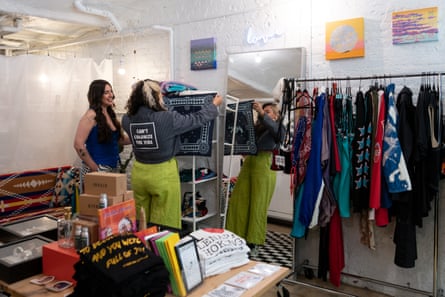
Emmerich: We’ve been planning and organizing together for so long that we just naturally gravitate towards each other in our work style. Liana is analytical and does the logistical things as well as planning, and organizing when it comes to programming. I have this more creative, community outreach part of my work where building relationships is such an important aspect.
How are you staying afloat?
Emmerich: It’s been a huge challenge. We don’t have any major backing, so we are continuing to look for grants.
How do you choose what goes in the store?
We’re doing contemporary work here and now. There’s no rule that says we have to only exist in a historical contextLiana Shewey
Shewey: Our goal is to showcase contemporary Indigenous designers who are doing fun, subversive, wearable work, as opposed to the assumption of what Indigenous design has to look like. I want to talk about how Indigenous people exist here and now and we’re doing contemporary work here and now. There’s no rule that says we have to only exist in a historical context.
What is it like operating an Indigenous business within a community that so rarely acknowledges it’s on Indigenous land to begin with?
Emmerich: Even though Relative Arts may be the first of its kind, we are not the first ones to be doing this work. It was amazing to have the American Indian Community House come to open the space on our first day, to say a prayer and give us their blessing.
Shewey: I’m thinking about how many people come off the streets and buy one of our pieces just because they like the garments themselves. Then they look at the basketball jersey and ask: what is the Salish Sea? [The Salish coast, along the north-western US and Canada, is home to Indigenous nations.] If they didn’t know, they walk out having learned about decolonization.
Why do you think the fashion world has been so slow to include Native designers?
Emmerich: We’re often sidelined and continue to be marginalized. Magazines will run pieces saying, “Here’s some great Indigenous designers to shop from,” instead of just being a part of the overall narrative.
Shewey: Vogue just covered the Santa Fe Indian Market. It had never been in Vogue before, and it’s like the largest event in Santa Fe.
What advice can you offer for working with a friend?
Shewey: Good ideas are good ideas. But business is totally different. You’re entering what is hopefully a lifelong relationship with somebody. And I think that making that commitment in itself is something that needs to be talked over especially when you’re talking about owner percentages, that in a world where we want everything to be equitable. And it’s important to just really, really consider who is willing to take the initiative to be a business owner, rather than somebody who’s just working in a cool store, because it’s not always going to be sunshine and rainbows.
What is your long-term goal?
Emmerich: We like to think of Relative Arts as a hub. The plans that we have are so much bigger than just a store.
Shewey: I have so many visions of what we are going to build. We’ve mused that we want it to kind of look like an Indigenous-futurist version of Andy Warhol’s Factory. It would be so wonderful to have thousands of feet, although I doubt Andy ever had to apply for funding.


